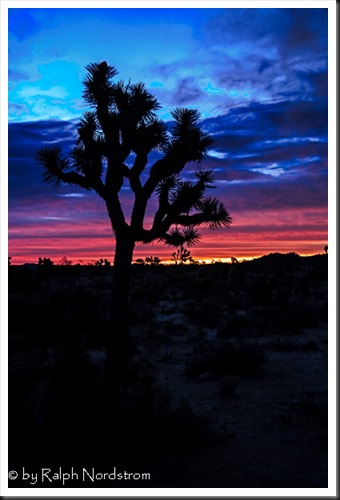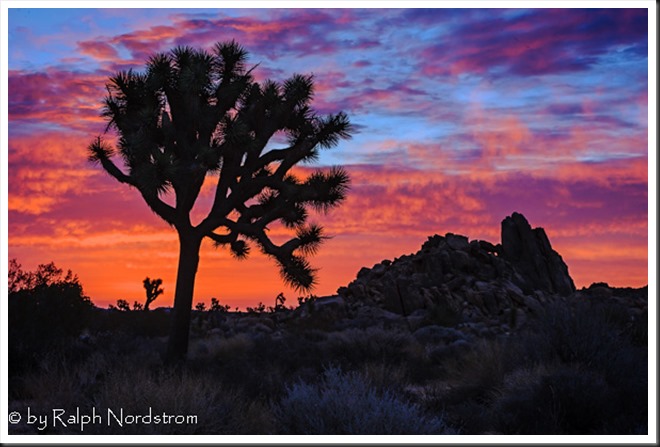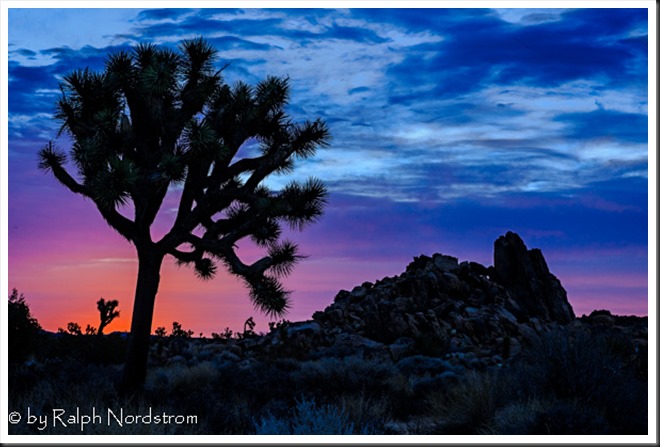Not long ago I was photographing dawn in Joshua Tree National Park. I must confess, dawn is my favorite time of day. And I have thrilled to more spectacular dawns in Joshua Tree than anywhere else. There are ;often clouds that ignite as the sun approaches. And the other morning was no exception.
I’d like to share with you three photographs taken that morning. The alarm went off at 4:30 and we left the motel in Twentynine Palms a 5:30, an hour and a half before sunrise. There were clouds in the morning sky, the first ingredient for a spectacular sunrise but by no means a guarantee. I selected Sheep Pass at the west end of Queen Valley because it offered both Joshua Trees and some impressive granite outcrops for an interesting foreground. We arrived about 45 minutes before sunrise. It was still dark with the barest glimmer of light in the east.
The clouds were pretty dense and it wasn’t clear if sunrise would happen. But 33 minutes before sunrise the glow was beginning to get some color.
It was still dark enough that we needed out headlamps to safely get around. I underexposed this image by 3 stops and it still required 4 seconds at ISO 200 and f/8 to capture it. I expected the final image to be mostly silhouette but in working with it I could pull out a little detail without noise. I always prefer detail in the shadows, even if it’s very subtle.
In the time between the this and the next photograph it got light enough to run around and find an interesting foreground (and I do mean ‘run’). As I already mentioned, Sheep Pass has some fascinating granite outcrops. And there was a lull in the activity in the clouds. I still wasn’t sure if it was going to happen or not. But if it did I wanted to be ready.
And it did. I was able to find the foreground I had envisioned so at 9 minutes before sunrise I got this image.
Yes, it was happening! I underexposed this 1 stop to saturate the colors and darken the foreground. The settings were ISO 200, f/10 at 1/15 sec. There were some separation concerns with this composition. The branch that reached down to the right needed to be separated from the rock outcrop behind. And the Joshua Tree trunk needed to be separated from the trees behind it on the horizon. Also, the clouds at the top needed to be fully included within the frame. It was not difficult to do, just needed to pay attention, lower the camera and move the tripod around a little. As with the first shot the foreground was silhouetted but still retains detail.
This is what I love about mornings in Joshua Tree – spectacular sunrises like this.
I thought the show was over and was just standing around talking when I looked up and saw this final image. The color in the clouds had faded and retreated into an amazing glow on the horizon. The effect is subtle but the glow behind the Joshua Tree gave it a spiritual quality.
This image was captured just 3 minutes after the first and six minutes before sunrise. It is also underexposed by 1 stop with the same exposure settings as the previous photograph. Two minutes later the glow was gone.
Sunrise Light
Sunrise can be very difficult to photograph. You arrive on location while it’s still dark and things happen very fast. The biggest challenge is to find a good composition with a compelling foreground in the dark – not an easy assignment. Being familiar with the area is a big advantage.
Besides finding a winning composition it’s helpful to understand the sequence of events at sunrise. A prerequisite for a sunrise like the one we experienced here is clouds. But that does not guarantee success because the sunlight needs to be able to get under the clouds. If the sunlight can’t get under the clouds they will never be able to light up. I think one of the conditions that makes Joshua Tree such a great place for sunrises is to the west it’s close enough to the Southern California basin that it gets moisture to form the clouds. But as you travel east you get into more and more dessert which means the clouds end and the rising sun is not obstructed.
The action starts between nautical and civil twilights with most of the excitement occurring during civil twilight and just after. Nautical twilight begins when the sun is 10 degrees below the horizon and civil twilight, when the sun is 5 degrees below. In practical terms for most of the areas where I photograph, nautical twilight begins about an hour before sunrise and civil about a half hour before.
There’s a progression of colors on the clouds as the sun approaches the horizon. The first colors to appear are the reds and pinks. The sky at this time is a beautiful baby blue and the colors can be quite exquisite. As with the example above, the colors start near the onset of civil twilight and intensity builds until near sunrise.
As the sun gets very close to the horizon the colors in the clouds will transition from pink to gold. And the gold color will persist as the sun raises its head above the horizon, but not for long. While we may have that beautiful golden hour light on Mother Earth, high above in the sky the clouds no longer have the benefit of the sunlight passing through so much atmosphere and they quickly turn to the color we are most familiar with – white. If you want to capture the gold in the clouds you have to be very quick about it once the sun is up.
Summing It Up
The key to a great sunrise photograph is no different from any other landscape photograph – optimum exposure, appropriate sharpness, strong composition and fantastic light.
Underexposing will saturate the colors in the sky and silhouette the foreground. If you want to have more detail in the foreground then shoot HDR. In general focus and depth of field considerations are no different for sunrise then for any other time of day. But it may be more difficult to focus in the dark.
A strong composition is perhaps the biggest challenge at sunrise. Compositions are difficult to find in the dark. Scouting the location the day before you shoot is ideal. And programs like TPE (The Photographer’s Ephemeris) are invaluable in making it possible for you to work your composition around where the sun will rise.
The fantastic light is at the mercy of atmospheric conditions. To get the great pinks and reds you must have clouds. But for the clouds to ignite there has to be an opening to the east so the sunlight can get underneath them. If you’re shooting sunset the opposite is true – the opening must be to the west. It’s difficult to tell if the opening is there because it may be out of sight beneath the horizon.
When it all comes together like it did this morning it makes getting up at 4:30 more than worth it.
Join the conversation. Please feel free to share; your experiences by leaving a comment.
If you found this post helpful please you can Like it, share it on Facebook or Twitter or email it to a friend.
Join me on an upcoming workshop. Click here for more details.
To see more of my photographs click here.
(2173)




Great set of photos and a good discussion re: sunrise photos.
I spend time photographing Nubble Light in Maine because I live about an hour away. I’ve watched many sunrises over the years and never found a way to predict what mornings the clouds may light up with color. I always arrive at least an hour ahead of sunrise. I stand on the rocks looking for reflections in tidal pools or how the lighthouse beacon reflects on the water. Yes, takes the guess work out for when the sunrise appears.
When the light starts peeking over the horizon I’m already in position and generally see just a few brief minutes of “sweet” light. Also, pay attention because sometimes the clouds line up just right for a color show after sunrise. I watched a spectacular light show last November 28; clouds at sunrise and then a few minutes later the clouds parted for a brief moment with lots of beautiful yellows.
My question, when you watch a great sunrise, what song’s going through your head? Yes, you need a song. The Beatles “here comes the Sun?” Katrina and The Waves “Walking on Sunshine?”
Thank you again Ralph, for a great time. I learn a lot every time we all meet at Joshua Tree, I did miss the camp fires and the single malt, though. Thanks so much, be well and safe.
John